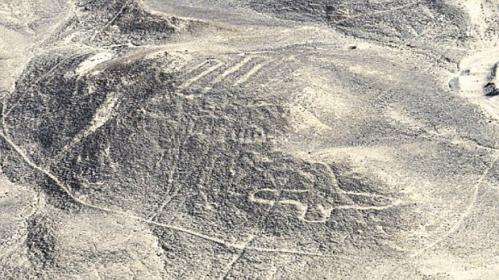August 7, 2014 report
New geoglyphs found in Nazca desert after sandstorm

(Phys.org) —While flying over the famous Nazca desert recently, pilot Eduardo Herrán Gómez de la Torre spotted some geoglyphs that had not been seen before. He believes the geoglyphs or Nazca Lines, as others call them, were exposed after recent sand-storms carried away soil that was covering them.
The Nazca Lines have become world famous, showing up in paintings, movies, books and news articles. They exist on the floor of the Nazca desert in a southwestern part of Peru, near the ocean. Scientists believe the figures (approximately 700 in all) were created by the ancient Nazca people over a time period of a thousand years—500BC to 500AD. The geoglyphs vary in size and have been categorized into two distinct categories: natural objects and geometric figures. The natural objects include animals such as birds, camelids, or snakes. It is believed the lines were created by removing iron-oxide coated pellets to a depth of four to six inches—that left the lighter sand below in stark contrast to the surrounding area. The images vary dramatically in size, with the largest approximately 935 feet long. It is a myth that the figures on the desert floor can only be seen by aircraft (they were first "discovered" by a pilot flying over the desert in 1939). In fact, they can be seen quite easily when standing on nearby mountains or hills.
The newly revealed figures discovered by de la Torre are of a snake (approximately 196 feet in length), a bird, a camelid (perhaps a llama) and some zig-zag lines. They are actually on some hills in the El Ingenio Valley and Pampas de Jumana near the desert floor. Archeologists have been alerted to authenticate the find.
The reason for the creation of the geoglyphs is still uncertain, though a host of possible explanations have been offered, many centered around religion and or water. Interestingly, all of the figures are believed to have been created using a single line that never crosses itself. Similar to how a picture might be drawn with a pencil, never lifting it from the paper. It has also been noted that many of the images depicted by geoglyphs also appear on pottery made by people over the same time period, and, archeologists have found evidence of wooden stakes used to help create the images, suggesting they were made using very simple techniques.
More information: via Elcomercio
© 2014 Phys.org





















